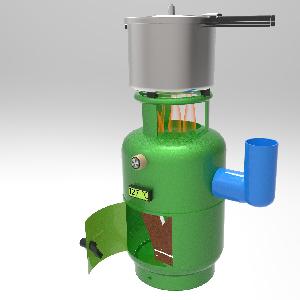 Climate Rescue Jun 10, 2016 07:12 | Great idea to reuse gas cylinders that can no longer be used or refurbished. May I offer suggestions that could avoid potential snags when you try building one of these:
|
 Aadhithya Sujith Jun 12, 2016 07:20 | Proposal contributor Thanks for your feedback and suggestions which has helped to make my concept and design better.
I planned to keep LED display not in direct contact with cylinder but separated by a thick layer of Bakelite which has high thermal resistance the same material used in handles of frying pans but to avoid any issues with heat radiated due to continuous using I have modified to thermal stickers, the temperature indicating stickers or analogue thermometer. The regulator is good enough as it can be made up of bakelite, regarding fans high temperature resistant motors are now available. 2.I have included the designs with wood placement uniformly around the heat radiation source, the trick is to reduce humidity of surrounding air by warming it which allows more moisture to evaporate from wood and hence drying it. 3.The exhaust pipe is required to make it smokeless, this will eliminate another problem of choking smoke during cooking, which is a major problem faced by women around the world. 4.The wood is not preloaded, the wood is loaded slowly through the input port according to the burning of fuel. |
 Erich J. Knight Jul 20, 2016 06:42 | I offer suggestions that could also build soil carbon; Turning your stove into a TLUD, Top Lite Up-Draft gasifier JRO; TLUD / Retort hybrid |
 Aadhithya Sujith Jul 21, 2016 11:13 | Proposal contributor Thanks for those interesting links. I have recently been to Shell Eco marathon, there in their innovation lab I have seen people using coffee beans waste to cook food. |
 Pia Jensen Jul 27, 2016 10:01 | Hello, I live in Uruguay and have lived in Costa Rica and Nicaragua and when I think about this proposal, I think, oh, no, few people can afford to get those gas tanks for cooking purposes as it is - cycling them into a different purpose won't make sense to them because, in the current paradigm, it is much easier to cut and burn wood for cooking and heat, which is what many do because the gas tanks are so expensive. How do you address real world situations regarding access/costs? |
 Aadhithya Sujith Jul 28, 2016 08:15 | Proposal contributor Thanks for your comment. I am not proposing to buy a gas cylinder and reuse it to make the proposed stove but to reuse abandoned and unused gas cylinders to make the proposed stove. Gas cylinders have an expiry date and it is unsafe to use it after that period so naturally the metal has to be scrapped, melted and rebuilt into a gas cylinder which I believe is waste of lot of energy and the energy required for the same may cause emissions which are responsible irregular climatic conditions. There are millions of unused and abandoned gas cylinders in sub saharan region alone and my idea was isnpired by it. The world's most poorest people live in sub saharan African region. http://borgenproject.org/the-worlds-poorest-live-in-sub-saharan-africa/ Even in my home country India some parts of it is still developing a lot of scope. Also there are additional benefits for using this type of stove rather than simply cutting wood and burning it. The proposed stove is smokeless gas cylinder stove, women around the world along with small kids have to inhale the smoke from cooking stoves by normal cutting and burning of wood, my idea proposes to make their lives better as it gives a modern touch to conventional burning of wood.
|
 Pia Jensen Jul 28, 2016 11:35 | I understand now... your part of the world views them differently - the tanks are a "hot commodity in Latin America, I've never seen anyone leave them unused. They get recycled even with pinholes (not safe or smart, but true) then when completely unusable they become a base for a chair or table. I'm not sure what the industry standard is when they have them and can't recycle them anymore, but they aren't found easily. Thanks for explaining. |
 Climate Rescue Jul 30, 2016 08:00 | You should consider building at least one of these. Then you would discover whether:
Good luck! |
 Aadhithya Sujith Jul 31, 2016 05:32 | Proposal contributor Thanks for your insightful questions. Please find my responses below.
It can be done as shown below using cutters. Man will be soon going to Mars so cutting a circular hole seems less challenging. 2.small high temperature fans, wires and electronics are affordable? These are good to have features in my smokeless gas cylinder stove but not necessary for primary function. I just wanted to give them a modern touch to conventional stove. A conventional temperature sticker should measure temperature no need of electronics. Fan is optional, a fan that operates under high temperature could supply more air and improved combustion. However if this is not possible a foot pump will fix this problem. 3.the large furnace volume serves any purpose when fuel is fed-in not preloaded? The furnace can hold wood as fuel but the fire has to be lit through the fire door so large furnance volume serves this purpose. 4.The extra chimney serves any purpose, since smoke is created earlier in the process? The smoke is safely taken out through the smoke exhaust port. This will ensure natural draught and easy flow of exhaust out of the stove. 5.Radiated heat can actually be used to dry wood, since the first inch of wood insulates everything beyond? The wood kept around the stove can easily be dried by convection and heat radiation. The subsequent layers of dried as well even though it is insulated by earlier layers of wood because when the stove heats up due to heat radiation the air surrounding the wood and stove heats up and reduces the humidity out of air which means it increases the rate of evaporation of moisture from wet wood. It is a common practice to see people storing firewood near conventional stove to dry wood, even I have seen my grand parents do that some time ago and it is very efficient.
|
 Climate Rescue Aug 1, 2016 04:07 | Nice job with the circular hole! When you continue building your cookstove you will find answers to the other questions. |
 Aadhithya Sujith Aug 1, 2016 11:31 | Proposal contributor Thanks for all your queries and suggestions. Please feel free to invite me to any other projects you are working on at climate colab platform. |
 Erich J. Knight Aug 9, 2016 01:12 | Clean Biomass cooking is no small thing. |


